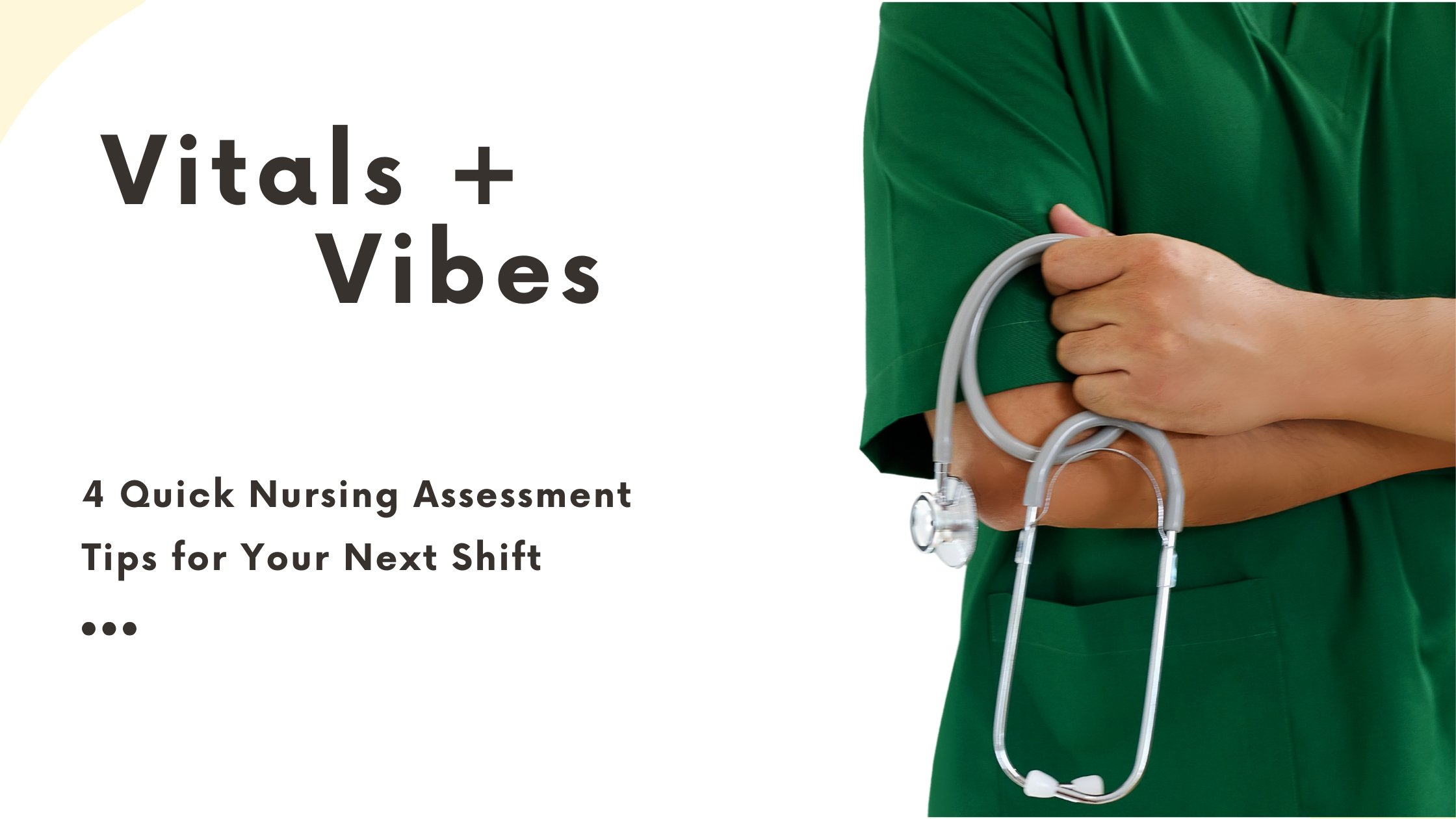Articles contain affiliate links. For more information on affiliate links, click here
Alright, so that probably wasn’t the best way to phrase what I’m going to be talking about in this post, but it’s definitely what you probably searched to find this information!
Maybe you’re starting nursing school clinicals, or maybe you’ve been away from the bedside for a while and are returning to care for patients, and need to refresh your skills on how to effectively clean a bed-bound patient who has had a bowel movement. Well, you’re in the right place! Let’s get into it! (The details, I mean…)

Table of Contents
How To Clean An Incontinent Patient
Let’s go through the practical steps to change a bed for an incontinent patient.
Quick tip ➡️ I go through a video demo of this nursing skill (and many others) in an online course designed specifically for new nursing students. If you are reading this post to get ahead of the game in clinical, consider checking out 👉 Nursing Skills Refresh 👈 for more insider tips and demos so you can look like a pro on day one!
1. Gather Supplies
First, take a look at the patient and assess the situation. Is this a full bed change (meaning we need a gown, incontinence pads, and a full set of new linens), or do we just need a new pad and some wipes?
Checking first is especially important if the patient is in an isolation room, and running out real quick to grab something isn’t a fast process. You also don’t want to take in a bunch of unnecessary supplies because they pile up quickly.
You will likely need another person, as turning a bed-bound patient is almost always a two-person job. The only time it’s a one-person job is when the patient has enough upper body strength to hold themselves on both sides (which doesn’t happen often!).
Before moving the patient, it’s helpful to have your clean linen within arm’s reach and a trash can nearby as well. Grab your gloves (and possibly double gloves!) and let’s get started!
If At Home ➡️ Supplies I Would Have On-Hand
Let’s say you’re doing this at home with a loved one, or maybe you’re wanting to bring in your own supplies to where your loved one is receiving care. You can view all of my Amazon product recommendations here 👇 in My Amazon Storefront.
- Incontinence bed pads – 2 options, these protect your linen and mattress. They are a must-have! You can get both, using disposable ones as a backup if no washable ones are clean.
- Disposable – These are one-time use and are preferred; however, if you anticipate long-term use, it might not be cost-effective.
- Washable – These items require an additional step: you need to wash them (and wash them well!) to reuse them. Therefore, once they are soiled, you must have a way to remove any excess soiled material before putting them in the laundry. The washing and care of them is similar to reusable baby diapers.
- Wipes – Incontinence wipes are very helpful, especially for quick cleans. They are disposable (do NOT reuse them), but make sure you don’t flush them – even if the product says it’s flushable. If you’re getting them for yourself or a loved one and they are female, get a pH balanced product to protect the natural flora of the vaginal area.
- Diapers – I don’t love using these long-term because they trap moisture on the skin. However, if you’d like to use them, make sure you get the right size (might need to purchase a smaller package and try out different sizes before buying in bulk) and ensure you get the ones with TABS. Do not get pull-on ones. These are much more challenging to remove and apply. The tabs allow you to lay them flat on the bed while turning the patient. Do not reuse these.
- Disposable gloves – You don’t need anything too fancy, just not the cheapest ones. It’s good to have the appropriate size. Most people wear a medium. Do not reuse these.
- Isolation gowns – This is something you don’t need, but it can be very helpful if you’re cleaning up when it’s particularly messy and you want to protect your clothing.
- Soap and water kit – Sometimes wipes don’t do the job fully, and you need to use soap and water, which is highly effective and will clean intact skin well. You can get a plastic wash basin to put warm water in and lather up gentle soap. I recommend having a designated set of wash cloths for incontinence care. You need to have quite a few, as you should never put a used or dirty washcloth back in the clean water.
Trash – Consider a dedicated trash can with a lid to prevent repeated trips to the garbage bin outside. It can also be helpful to have a dedicated laundry area for reusable items, which will enable you to keep it all separate in the wash.
Ok, whether you’re in the hospital or at home, let’s say you’ve got all of your supplies handy! Let’s walk through all of our steps.
2. Roll The Patient
The patient will have to roll side to side while each of you takes turns cleaning and rolling out the dirty linen, and placing new linen on the bed. Therefore, each person needs to stand on either side of the bed. Sometimes, it’s much easier for a patient to roll to one side or the other (in particular, stroke patients who have hemiparesis).
If the patient is verbal, ask them which way they prefer. The first time they roll to their side will take the longest.
Let’s say you’re going to be the first person to clean. Roll the patient away from you and have your coworker stabilize and hold them on their side. You can have them bend the leg closest to you 90 degrees, turn their hip towards your coworker, and pick up their shoulder, turning them on their side.
Tip ➡️ If the patient is able, have them hang on to the side rail
Another tip ➡️ If the patient is pretty dirty, wait to turn them. Sometimes feces can sneak through to the front, especially if patients have diarrhea. If this is the case, clean the front first before turning. If there is a lot, you can push it down to their backside, between their legs, and place a towel or more clean wipes on top to prevent it from getting dirty again while the patient rolls. Cleaning the front first is helpful because it’s hard to do that with a patient on their side. If the patient is able, you can also “frog-leg” them, which exposes more, thus enabling you to clean better.
Make sure your coworker is stable and has a good grip, and then get to work.
3. Clean The Patient
First, use your wipes to clean all excrement off of their skin. Feel free to put your dirty wipes on the dirty pad because you’re going to throw it away anyway. (Don’t do this if you’re using washcloths, though!) Please pay very close attention to any broken skin. If the patient has had repeated incontinence, their skin may be raw or irritated. Take special care in these areas.
Clean. Clean. Clean. Once their skin is clean, make sure it doesn’t touch the dirty pad or linen as they turn. Ensure the skin is dry. (Using a clean washcloth is helpful!)
If you need to change all of the linen, you’ll then pop the corners of the linen off of the mattress. You will tightly roll the dirty linen and push it under the patient. If the pad isn’t too dirty, you can roll it so the messy stuff is completely covered up and the only thing touching their skin is the back of the pad.
However, this may not be possible due to the amount of feces or its location. If so, grab a towel to place between their clean skin and the pad, then roll it up.
Roll all of this up and push it as far as possible under the patient while they are still on their side.
In the video below, I walk through how to put a patient on and take a patient off a bedpan. The movements are very similar, so if this explanation is confusing, be sure to check out this video for a demo! 👇
4. Put On Clean Linens
Now, grab your clean fitted sheet and pop it on the corners of your side of the bed. Push the clean sheet as far as possible under the patient without displacing them. Then get your draw sheet, disposable pad, and/or brief (sometimes referred to as a diaper) and place it on the patient halfway, and pull it up between their legs.
From your side, you should see: the patient’s clean backside, the sheet attached to the two corners on your side of the bed, the sheet halfway covering the bed and lying flat, and a disposable pad rolled up and placed under the patient.
5. Turn The Patient Again
Now, it’s time to turn the patient toward you and have your coworker finish up. Tell the patient they’re going to roll over a big bump, and slowly roll them towards you.
6. Repeat On the Other Side
Now, you will hold the patient in a comfortable position on their side. Your coworker will pull out all of the dirty linen, carefully so as not to dirty the new linen. They will clean any additional skin that is still dirty. Then, they will pull through all of the clean linen, attach the sheet corners to the bed, and flatten out the pad. Then the patient can be laid on their back.
7. Make Final Adjustments
Once the patient is flat on their back, change their gown or clothes. If it was visibly soiled in the beginning, you’d want to remove it earlier and wait to put the new one on until they’re all squeaky clean. They will naturally have sunk into the bed and will need to be boosted up.
Boost the patient, ask if they want just a sheet over them or a blanket as well, place pillows where they prefer, and spray some deodorizer if necessary.
Some people feel bad about spraying deodorizer, but let’s be honest – the patient knows they had a bowel movement, knows you just cleaned it up, and spraying a little room deodorizer isn’t what’s going to upset or bother them. They typically appreciate it. (And they probably don’t want to smell it either!) This is especially helpful if you have to ask guests to step out and you know they’ll be returning to the room. Do what you can to make it seem like you didn’t just do what you did. This may also include taking out the trash, even if the bin isn’t full.
Before you leave, make sure they’ve got their call light nearby, bed alarm back on, and all necessities within arm’s reach.
Tips to Prevent Injury
Patients can make unpredictable movements, or you can be in an uncomfortable position, or they can be quite heavy. You must take the necessary steps to prevent injury. I know multiple nurses who can no longer work at the bedside due to an injury they sustained there.
Adjust the Height of the Bed
Adjust the patient’s bed to a comfortable height for you, ensuring you’re not bending over for the entire time and straining your back.
“But I’m only doing this really quickly! Why does it matter!?”
Well, you might be doing the task quickly, but you’re likely also doing it over and over again during each shift. This repetition creates a situation that can negatively impact your back.
Lift Correctly
When lifting or moving patients, use proper ergonomics: lift with your legs and avoid twisting. We do not want an injury!
Use Assistive Devices
If you have lifts or assistive devices, use them.
Remember, injury is never worth it. Protect your back and your health. If you get injured while caring for a patient, don’t try to stick it out. Go to employee health and get it taken care of as soon as possible. Don’t be a hero!
Use Barrier Cream (if indicated)
Many patient will benefit from a barrier cream on their coccyx to prevent skin breakdown. This isn’t always appropriate, so check with the primary nurse if you are unsure. Make sure you check out my Amazon Storefront for some solid options.
Now you know how to clean patients after bowel movements!
Interested in Becoming a Nurse or a CNA?
Learning how to properly clean a patient is CNA and RN 101! If you’re not already a CNA, LPN, or RN – consider going to school to get paid to do this! 🙂 Click below to find programs accepting students in your area 👇
Frequently Asked Questions
Here are some answers to questions people might ask. If you have more questions, let me know. I’m happy to answer them.
How do you clean an elderly patient after a bowel movement?
Cleaning up a bowel movement for an elderly patient follows the same guidelines outlined above. Since the elderly often have fragile skin, pay close attention to this and execute the procedure with the gentleness required to prevent skin tears or injury.
How do you clean a bedridden patient?
Generally, only patients who are bedridden will need to be cleaned. The steps outlined above will help you fulfill this task. If a patient is not bedridden and requests a nurse to clean this, it requires additional investigation. There may be legitimate reasons, but generally, you should encourage patients to perform as many ADLs (activities of daily living) on their own as possible.
Do nurses clean poop?
One of the most surprising things for many nursing students is that nurses clean poop. Nursing students will often encounter many opportunities to clean feces. However, not all nursing specialties do this routinely. If you work in an office, perioperative, or other ambulatory settings, it decreases the likelihood that you’ll have to clean it up, but never say never!
Do CNAs or certified nursing assistants clean poop?
Yes, they often do. However, it depends on the nursing units where the CNA is working. CNAs who work in regular hospital units, such as med-surg, ICU, cardiology, orthopedics, oncology, as well as in nursing homes and skilled nursing facilities, will. However, CNAs who work in settings like outpatient clinics likely will not.
Which nurse jobs do not clean poop?
School nurses, operating room nurses, public health, outpatient dialysis, infusion, case management, and outpatient nurses typically do not clean up after incontinent patients. Advanced practice nurses (APRNs, such as nurse practitioners and CNRAs) do not either. While APRNs can and know how to do this, they are typically not providing direct care and are functioning in a provider role, which would not include cleaning up patients.
How often do nurses clean poop?
If you work in a hospital or nursing home, you likely do this every shift.
Do you have to clean poop in nursing school?
While everyone’s clinical experience is different, this will likely be part of your nursing school education.
More Resources For Nursing Students
- Head to Toe Assessments vs. Focused Assessment – blog post
- Nursing School Planner – free workbook to compare schools, track costs, and make wise decisions
- FreshRN Nursing Student Resource Hub
- Interested in becoming a CNA, LPN, RN, or grad school? Check out my nursing degrees and programs learning hub
- 10 Mistakes Nursing Students Make (And How to Avoid Them) – free 26-page ebook
- How to Pass Nursing School Exams
- How to Survive Nursing School Masterpost
Trying to choose between med surg vs ICU? Learn how the roles differ, what skills you’ll build, and how to pick the right path for your nursing career, plus get course recommendations for both.
AI is reshaping how nurses learn and educators teach. Discover the latest trends in AI and nursing education, including personalized learning, VR simulation, and how to prepare for an ethical, equitable future in healthcare training.
Continue Reading AI and Nursing Education: Trends, Tools, and the Future of Learning
Learn what a clinical nurse consultant does, how to become one, and what skills are essential to thrive. We sat down with Kristine Shepherd, MSN, RN, for the full scoop.
Continue Reading What Is a Clinical Nurse Consultant? A Behind-the-Scenes Look at This Growing Role
Streamline your nursing assessments with real-life tips to help you stay efficient and confident (even when your shift is chaos). Perfect for new grads finding their flow!
Continue Reading 4 Quick Nursing Assessment Tips for Your Next Shift
What does a “medical surgery nurse” do? Learn the correct spelling of “med-surg,” what it’s like to work on a medical-surgical unit, and why it’s one of the most important specialties in nursing.
Continue Reading Curious About a “Medical Surgery Nurse”? Let’s Talk Med-Surg
How long does it take to go from BSN to DNP? Let’s talk what affects the timeline, and how BSN to DNP programs compare to other nurse practitioner paths. Plus tips for choosing the right program.
Continue Reading How Long Does it Take to Go From BSN to DNP? Let’s Discuss.
Feel like nursing school didn’t prepare you for clinicals?

Nursing clinicals are awkward at first. You’re surrounded by experienced nurses, real patients, and you’re just trying to figure out where the gloves are. It’s a lot.
That’s why we created Nursing Skills Refresh—to give you a realistic, supportive head start. You’ll get demo videos of common procedures, insider tips from two experienced nurses, and a clear picture of how a shift actually flows. (and a lot more) The goal? Walk into clinicals feeling like you belong there—not like you’re in the way.
Start Now









Question; If you were to get excrement on your face while changing a patient, do you take a moment to stop and clean yourself up before proceeding, or do you finish the job first?
A friend of mine is a nurses aid and had this very unpleasant thing happen to him. As he reached for a wipe to clean his face he was sharply reprimanded with “You finish your job first then clean yourself!”
This is not a joke.
I would be interested you read your reply!
So, I’ve actually had this happen to me! I would absolutely stop and clean myself. Feces on my face? Um – I don’t care how mad that other nurse gets – I’m cleaning it off my face before I continue. The only time I would consider not immediately pausing for a moment to clean myself up would be if the patient was hemodynamically unstable and it was an emergent situation. Honestly, kind of sounds like this person went on a power trip. I wouldn’t give it much weight. There’s no (spoken or unspoken) nursing rule when you need to finish the patient first before cleaning yourself up. Honestly, if I were a patient and noticed that, I’d tell the nurse to go take care of themselves first and I would gladly wait.
Is it ok to wear a mask when cleaning a poopy patient even if they are not on any precautions? An ER nurse once told me that every nurse has their “thing” that completely grosses them out. She said hers was poop. She dealt with it by wearing a mask when she deals with a poopy patient or has to change a colostomy bag, etc., and she puts peppermint essential oil on the inside of her mask to cover the smell of the poop.
Absolutely. This is a lot like spraying the room deodorizer. The patient knew they had a bowel movement, they know that you had to clean it up. There is no reason why you can’t wear a mask if it helps.
If the patient is constapated would it be ok to put q tips to break it up
In that case, I’d chat with the physician and get an order for an enema or something. You don’t want that to break off and get stuck in there and make things worse.
I do a thing in the event of faeces being glued on; I douse it with lotion to soften it for easier removal.
I find it especially helpful when skin is like tissue paper.
Is it possible to do this procedure without help? None of the nurses seem to help CNAs with this job.
It would be helpful for her to answer your question. I’m curious as well.
Of course, sometimes you can easily do it without help. But there are times you just cannot go it alone. In that case, as the nurse or CNA of that patient, you always take the business end.
I am not trained, but have recently taken on the responsibility as caretaker of my 84-year-old mother. Although not a concern when I started six months ago, her conditions have recently progressed to incontinence. I’ve always had an impression that we need to take care to avoid wiping fecal material into the genitalia–concerns include UTI as well as other consequences. So, my question is what is recommended to ensure adequate cleaning – especially when fecal matter has been in a diaper and spread toward the front of the patient? (Incidentally, my mother remains fiercely private and does not like anyone, including me, “pushing and poking” around her nether areas. I’m trying to understand what is important and what can be deferred.)
You essentially wipe front to back, and to appropriately clean after fecal incontinence in a diaper, you, unfortunately, must get to the “nether regions” or else a UTI can result. I recommend using warm wipes or washcloths that have been in warm water, and you could always have her use the wipes on the front side and push down towards the back and you clean the backside. Regardless, it’s crucial to do that or she will get repeated UTIs. This is one of those things that even though she doesn’t want it to happen, it’s non-negotiable or else she’ll get UTIs. I recommend emotionally processing and validating her fear/concern about privacy, likely the grief that comes along with losing that important aspect of caring for yourself, and ask what you can do to make it easier/more bearable. It’s a big deal to become incontinent and suddenly people are in your privates multiple times a day, so I definitely encourage the supportive emotional component.
My Girlfriends Grandmother recently moved an elderly couple into their spare bedroom. The husband is in his early 70s and is cannot control when he releases his feces. His wife whom is ending her 70s; does not sanitize herself accordingly after attempting to clean him(I have witnessed her first hand proceed to cook and continue daily activities with feces still on her hands). It took about a week and some for the entirety of her house to be stained by this odor. It is strong and has masked the ability to taste any food.
I understand that the smell imprint can be misleading, but aside from the household residents not minding. I have noticed that my Son and his Mother have been stained with this odor and that I too am being informed that I am smelling of feces.
What issues could arise from My Son, His Mother and I being exposed to this environment?
This can lead to serious complications. Specifically, E. coli, adenovirus, campylobacter, coxsackie virus, giardia, hepatitis A, Salmonella, and Shigella. This is a major health issue and about much more than the scent. If she is preparing food, this can result in foodborne illness. It is imperative that there is adequate hand washing after anal hygiene, or people will get sick. I highly recommend doing two things. First, educating the entire household on the importance. This is a helpful link: https://www.verywellhealth.com/what-is-the-fecal-oral-route-1760046 I then recommend her wearing exam gloves when she is cleaning her husband. These are one-time use and are thrown away. A box of them is only around $5 and can be found at Walmart, Target, CVS, etc. I also recommend having hand sanitizer nearby as well. I wonder if there also is not proper disposal of incontinence pads or cleaning of his linen that results in the smell. If possible, after he is cleaned, it would be best to dispose of any materials used in an outside garbage container so that it is not in the household. However, it sounds like this couple likely needs more support and wonder if they would qualify for home health assistance through their doctor.
Given their age, they are probably already one some type of Medicare health plan, and if they do not have many assets, much income, are poor, on food stamps, etc, then they probably qualify for Medicaid also.
Under Federal law, if a single person makes less than $2,000 in income per month and do not have any countable assets that could be sold/liquidated for their value in cash to help pay for care, then they would qualify for Medicaid.
The rules change a little bit for married couples, but there are an equal number of ways to accommodate that difference for one person to qualify even if the other person might not.
Each state can have a higher maximum amount of income allowed per month (some states keep the $2k as maximum too… But some I know go up to $5,000) – increasing a person’s chances of qualifying.
Also – a person’s home, personal property like a single vehicle for transportation and household furnishings – these are typically not countable as assets and are considered to be basic necessities… Laws protect these things from being counted against a person’s eligibility for things like Medicaid but also vary by state. You may have heard of these laws being used to take advantage of a situation where a person might spend a bunch of money on a new house and furniture, appliances, etc, then declaring bankruptcy to get out of debt (then sell off the possessions later after creditors give up).
These same laws provide protections that can be utilized by the elderly to qualify for Medicaid to afford home health services.
Sometimes referred to as “shirt off your back laws” – (well-known in Florida). And the acts of spending your money to qualify for Medicaid in this way, if done right, is perfectly legal and very common. Known as “Medicaid spend-down”.
There are a lot of resources and information out there if you ask around at your grandparents’ doctor offices, ask to speak to their social workers and insurance brokers or patient advocates.
Or – if you can afford it – seek out professional help from a CERTIFIED Elder Law attorney whose practice primarily focuses on that area (not just a general family law firm).
And for power of attorney – springing power of attorney is never a good idea in situations involving the potential for diminished capacity in the elderly because they have the ability to withdraw that power or give it to someone else who may manipulate them at a later date before you have a legal ability to prevent it or even know about it since your power of attorney powers would not kick in until they have officially been deemed incapacitated.
If you’re patient hada bowel movement, and they were scheduled for a bed bath. Do you go ahead and start the bedbath, working head to toe first then cleaning/washing up the private areas? Or do you change them first then give the bedbath?
Depends on the extent of the situation but likely I think the patient would appreciate the stool being removed first, and then continuing on with the rest of the bed bath. I’d make sure to change gloves and wash hands once fecal matter is cleaned and proceeding to the rest of the bed bath. Whenever I knew my patient needed a bed bath that shift and discovered they had a bowel movement, I would just combine those tasks into one! It saves you time and the patient from having to go through it twice!
Any comments to do an easier job is appreciated. My 75-year-old stroked-out husband is in pullups but has a big poop mess at least 1 to 2 times a week. We have an extra small bathroom. with a small shower. I have to help him with the big messes! He can stand with his walker but is very unstable in his balance and finds it very hard to stand long enough to get the huge job done. Sometime takes close to 30 minutes. It is sticks to his skin. He drags it down the legs as the pull up comes off, gets his outside pants a mess inside. He wears himself out trying to clean himself and never does much good anyway and ends up getting the stool nastily covered in it. By the time I get there he is difficult to get cleaned up. To get at anything I have him stand at the lavatory sink and hang on! But as I clean him it is like I need gloves up to my armpits like a veterinary doctor. I don’t have those gloves. First, I got to get the first layer by overreaching towards the front because he cannot give me room to do it from the front, it will make him fall! Then I start with a great deal of water mixed with soap while he stands on a towel. I have to use wet paper towels then gravitate towards wipes as it gets better. I use a cinched trash bag inside a big 5 gallon bucket with a lid to throw away the waste. I spray down the entire stool until it is dripping and wipe away the worst then use new paper towel as it gets better and also respray. Floors lastly are mopped and remopped. Yuck yuck yuck!!!
Have you considered getting large incontinence pads made for beds, and changing him in the bed while he rolls side to side? It seems that doing this while standing is too difficult and unsafe.
nursing student also need to clean poop and vomit? If yes, then how many times do they clean it? Is it like most of the time nursing student clean?
Yes, nursing students will also do this. There isn’t a set number of times students do this and then they’re done and never do it again. Cleaning up after patients is simply baked into the experience of being an RN and a normal part of your workday. Some roles will encounter this more than others. (For example, if you’re a public health RN, you’ll never do this. If you’re an ICU RN, you will do this each shift.) Nursing students will be expected to jump in and help so they can learn how to safely clean someone up and practice. It gets easier and faster with time, and honestly experienced RNs don’t think about it much.
ALL OF THIS INFORMATION IS GREAT. I HAVE BEEN A NURSE FOR MANY YEARS, NOT A LOT OF HOSPITAL EXPERIENCE, BUT AM A SCHOOL NURSE FOR MOST OF MY CAREER. I APPRECIATE YOUR DOWN-TO-EARTH FACTS, AND TALKING ABOUT SO MANY ISSUES WITH BOWEL ISSUES THAT ARE VERY HELPFUL FOR A SCHOOL NURSE. NOT THAT I AM NOT AWARE OF THE ISSUES OF CLEANING THE PATIENT, BUT I APPRECIATE THE SUBJECT MATTER. YOU CAN ALWAYS LEARN. I AM SO IMPRESSED BY YOUR KNOWLEDGE, ESPECIALLY WITH A SUBJECT MATTER THAT I NEVER SEE INFORMATION ON, AND I READ A LOT. THANK YOU.
How do you clean a bedbound male patient that can not be rolled to either side due to pain issues. I can’t find anything that addresses this problem. I’ve read about the “frog leg” position but I don’t think that is an option either. We were using a sling to transfer to the toilet but right now due to pain he can’t use that without pain.